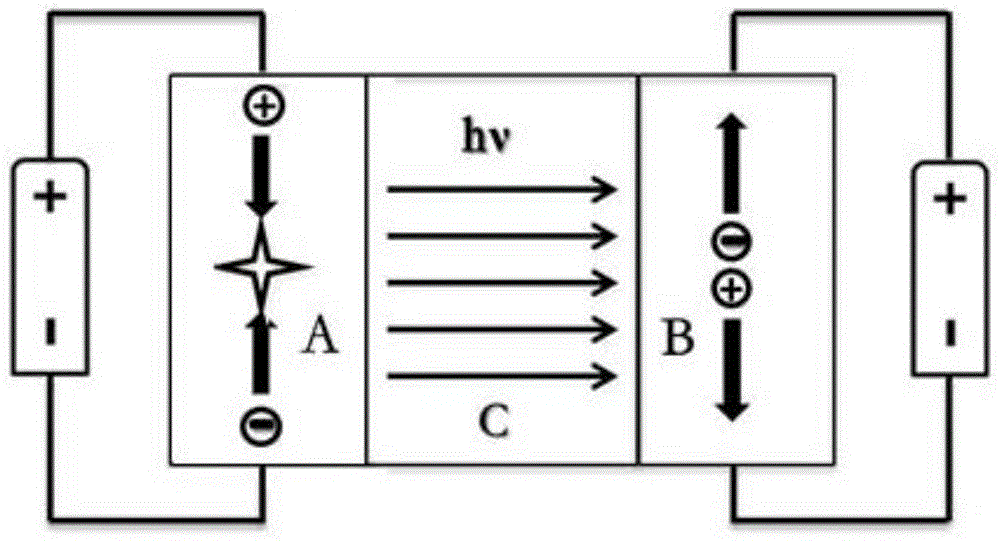A kind of optocoupler device and preparation method thereof
An optocoupler device and photosensitive technology, which is applied in the field of optoelectronics, can solve the problems of changing photosensitive effect, affecting signal conduction, and small current transmission, so as to achieve the effect of enhancing luminous intensity, expanding the range of color coordinates, and weakening the light source.
- Summary
- Abstract
- Description
- Claims
- Application Information
AI Technical Summary
Problems solved by technology
Method used
Image
Examples
Embodiment 1
[0056] This embodiment provides an optocoupler device, as attached figure 2 As shown, it includes a light-emitting film group A, a transparent electrically insulating isolation layer C, and a photosensitive film group B which are sequentially stacked on a substrate 1. The electrodes in the light-emitting film group A and the photosensitive film group B close to the electrically insulating isolation layer C are The same or different transparent electrodes.
[0057] The substrate 1 may be a glass substrate or a polymer substrate. In this embodiment, a flexible polyimide substrate is preferred.
[0058] The light-emitting film group A is preferably an organic light-emitting diode, which can be an organic small molecule light-emitting device or a polymer light-emitting device, and includes a first electrode 41 of a light-emitting film group, a light-emitting functional layer 42, and a second electrode 43 of the light-emitting film group. Such as Figure 4 As shown, the light-emitting ...
Embodiment 2
[0090] This embodiment provides an optocoupler device, as attached image 3 As shown, a photosensitive film group B, an electrically insulating isolation layer C, and a light-emitting film group A are sequentially prepared on the substrate 1 from bottom to top. The specific preparation method is:
[0091] S1. The second electrode of the photosensitive film group, the first electrode pin of the photosensitive film group, the first electrode pin of the light-emitting film group, and the second electrode of the light-emitting film group are directly formed on the substrate 1 using the magnetron sputtering process and mask. Second electrode pin;
[0092] The substrate is preferably a flexible polyimide substrate, and the second electrode of the photosensitive film group is preferably an aluminum electrode with a thickness of 100 nm.
[0093] S2. A photosensitive functional layer and a first electrode of the photosensitive film group are formed on the second electrode of the photosensiti...
Embodiment 3
[0108] This embodiment provides an optocoupler device. The specific structure and manufacturing method are the same as those in Embodiment 2. The only difference is that in this embodiment, the photosensitive functional layer further includes second p-types arranged on both sides of the organic photosensitive layer. A semiconductor layer and a second n-type semiconductor layer, and the second p-type semiconductor layer is disposed close to the light-emitting film group.
[0109] The second n-type semiconductor layer is an n-type semiconductor material layer, selected from but not limited to TiO 2 , ZnO and other inorganic semiconductor materials with greater electron mobility, this embodiment is preferably TiO 2 Layer with a thickness of 150nm.
[0110] The second p-type semiconductor layer is a p-type semiconductor material layer, selected from but not limited to organic semiconductor material polytriarylamine (PTAA), 2,2',7,7'-tetrabromo-9,9'-spiro 2. Tris(4-iodophenyl)amine (Spi...
PUM
 Login to View More
Login to View More Abstract
Description
Claims
Application Information
 Login to View More
Login to View More - R&D
- Intellectual Property
- Life Sciences
- Materials
- Tech Scout
- Unparalleled Data Quality
- Higher Quality Content
- 60% Fewer Hallucinations
Browse by: Latest US Patents, China's latest patents, Technical Efficacy Thesaurus, Application Domain, Technology Topic, Popular Technical Reports.
© 2025 PatSnap. All rights reserved.Legal|Privacy policy|Modern Slavery Act Transparency Statement|Sitemap|About US| Contact US: help@patsnap.com



